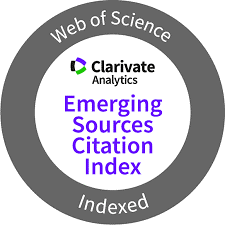La expansión global de los videojuegos. Riesgos de la concentración corporativa en la era del capitalismo digital
DOI:
https://doi.org/10.31921/doxacom.n36a1710Palabras clave:
Capitalismo digital, concentración, convergencia digital, industria cultural, videojuegosResumen
La relevancia del aspecto económico de la industria de los videojuegos se desarrolla a partir de una serie de procesos de concentración de corporativos especializados en las tecnologías de la información y la comunicación. Estas empresas trabajan a partir de una lógica capitalista donde dominan, controlan y dirigen las distintas etapas creativas del diseño y comercialización de éstos. Tomando en cuenta lo anterior, el objetivo principal de este es ensayo es establecer algunas de las características de la industria de los videojuegos en los procesos del capitalismo digital, a partir de sus procesos de concentración e integración. Las principales observaciones se encuentran relacionadas con los modelos de negocios de los grandes corporativos para desarrollar y comercializar videojuegos, al utilizar estrategias para evitar riesgos y generar procesos de monetización efectivos. Asimismo, la práctica de los videojuegos está redefiniendo hábitos de consumo donde predomina el uso intensivo del teléfono móvil para jugar, lo que genera nuevos fenómenos culturales. En este caso, las industrias culturales y creativas evolucionan de manera continua y permanente, por lo que la expansión de los videojuegos ha alcanzado un nivel de hegemonía planetaria en términos tecnológicos y económicos posibilitando el desarrollo de nuevas agencias.
Descargas
Citas
Armstrong, M. (2019). The companies making the most from games. https://www.statista.com/chart/8870/tencent-is-top-of-the-game-revenues-leaderboard/
Benjamin, W. (2006). The Work of Art in the Age of Mechanical Reproduction. En M.G. Durham y D. M. Kellner (Eds.) Media and Cultural Studies Key Works (18-40). Blackwell Publishing.
Birkinbine, B.J. (2017). Microsoft Corporation. En B. Birkinbine, R. Gómez y J. Wasko (Eds.) Global Media Giants (383-397). Routledge
Brookey, R. A. (2010). Hollywood gamers. Digital convergence in the film and video game industries. Indiana University Press.
Bustamante, E. (2009). De las industrias culturales al entretenimiento. La creatividad, la innovación… Viejos y nuevos señuelos para la investigación de la cultura. Diálogos de la comunicación, 78, 1-25.
Bustamante, E. (2011). La creatividad ¿contra la cultura?. En. E. Bustamente (Ed.) Las industrias creativas: Amenazas sobre la cultura digital (pp.15-19). Gedisa.
Carrasco, Á. y Saperas, E. (2012). La UNESCO y la institucionalización de la cultura: hacia un nuevo estatuto de cultura. Razón y palabra, 80.
Carrillo, J.A. (2015). La dimension social de los videojuegos ‘online’: de las comunidades de jugadores a los ‘E-Sports’. Index.Comunicación, 5 (1), 39-51.
Castells, M. (2009). Comunicación y poder. Alianza Editorial.
Castro, A. (2016). Industrias culturales vs Industrias creativas: un análisis crítico. https://www.researchgate.net/publication/314840453_Industrias_culturales_vs_industrias_creativas_un_analisis_critico
Clement, J. (2021). Most popular devices used for videogames in selected markets and regions as of January 2021. https://www.statista.com/statistics/1132960/popular-devices-video-games/#professional
Clement, J. (2021). All time best-selling Xbox One video game titles worldwide as of January 2020, by unit sales. https://www.statista.com/statistics/1091371/all-time-best-selling-xbox-one-game/
Clement, J. (2022). Gaming revenue worldwide 2021, by device. https://www.statista.com/statistics/278181/global-gaming-market-revenue-device/
Clement, J. (2022). Leading services for accessing digital video games in the UK 2021. https://www.statista.com/statistics/291838/leading-services-used-for-digital-video-games-in-the-united-kingdom/
Clement, J. (2022). All time best-selling PlayStation 4 video game titles worldwide as of August 2021, by unit sales. https://www.statista.com/statistics/953073/all-time-best-selling-video-game-ps4-global/
Comisión Europea (1997). Green Paper on the convergence of the Telecommunications, Media and Information Technology Sectors, and the Implications for Regulation. Comisión Europea.
Corbetta, P. (2007). Metodología y técnicas de investigación social. McGraw-Hill
Cuff, S. (2017). Now You’re Playing with Power: Nintendo and the Commodification of Nostalgia. University of Wisconsin Milwaukee. https://core.ac.uk/download/pdf/217192408.pdf
Dyer, N. y Sharman, Z. (2005). The Political Economy of Canada’s Video and Computer Game Industry. Canadian Journal of Communication, 30, 187-210. https://doi.org/10.22230/cjc.2005v30n2a1575
Garnham, N. (2005). From Culture to creative industries. An analysis of the implications of the “creative industries” approach to arts and media policy making in the United Kingdom. International Journal of Cultural Policy, 11 (1), 15-29. https://doi.org/10.1080/10286630500067606
Gee, J. P. (2008). Video Games and Embodiment. Games and Culture, 3 (3-4), 253-263. https://doi.org/10.1177/15554120083173
Giddens, A. (1986). The Constitution of Society. Outline of the Theory of Structuration. Polity Press.
Heredia, V. (2017). Revolución Netflix: desafíos para la industria audiovisual. Chasqui, Revista Latinoamericana de Comunicación, 135, 275-295. https://doi.org/10.16921/chasqui.v0i135.2776
Hesmondhalgh, D. (2008). Culture and Creative Industries. En T. Bennett y J. Frow (Eds.) The SAGE Handbook of Cultural Analysis (552-569). Sage Publications.
Horkheimer, M. y Adorno, T. (2006). The Culture Industry: Enlightenment as Mass Deception. En M.G. Durham y D. M. Kellner, Media and Cultural Studies KeyWorks (41-72). Blackwell Publishing.
Hutchby, I. (2001). Technologies, Texts and Affordances. Sociology, 35 (2), 441-456. https://doi.org/10.1177/S0038038501000219
Jenkins, H. (2006). Convergence Culture. New York University Press.
Karaganis, J. (2007). Structures of Participation in Digital Culture. Social Science Research Council.
Kellner, D. M. y Durham, M. G. (2006). Adventures in Media and Cultural Studies: Introducing the KeyWorks. En M.G. Durham y D. M. Kellner, Media and Cultural Studies KeyWorks (IX-XXXVIII). Blackwell Publishing.
Kerr, A. (2006). The business and culture of digital games. Sage Publicactions.
Kerr, A. (2017). Global games. Production, circulation and policy in the networked era. Routledge.
Knoche, M. (2021). Capitalisation of the Media Industry From a Political Economy Perspective. Triple C, 19 (2), 325-342. https://doi.org/10.31269/triplec.v19i2.1283
Labour Party (1997). Create the future: a strategy for cultural policy, arts and the creative economy. Labour Party.
Lefevbre, H. (1979). Space: Social Product and Use Value. En N. Brenner y S. Elden (Eds.), State, Space, World (185-195). University of Minnesota Press.
Miège, B. (2011). Theorizing the Cultural Industries: Persistent Specificities and reconsiderations. En J. Wasko, G. Murdock y H. Sousa, The Handbook of Political Economy of Communications (83-108). Blackwell Publishing
Murdock, G. (1997). Redrawing the map of the Communications Industries: Concentration and Ownership in the Era of Privatization. En P. Golding y G. Murdock, The Political Economy of Media V.1 (308-350). Edward Elgar Publishing.
Murdock, G. (2000). Digital futures: European Television in the Age of Convergence. En J. Wieten, G. Murdock y P. Dahlgren (Eds.), Television across Europe (35-57). Sage.
Murdock, G. y Golding, P. (2016). Political Economy and media production: a reply to Dwyer. Media, Culture & Society, 38 (5), 763-769. https://doi.org/10.1177/0163443716655094
Murphy, S. (2016). Grand Theft Auto V: Capitalist Hyperreality in the Age of Cynical Reason. En B. Kuhn y A. Bhéreur-Lagounaris (Eds.), Levelling up: the cultural impact of contemporary videogames (151-161). Inter-Disciplinary Press.
Navarro, J.G. (2022). Global box office revenue from 2005 to 2021. https://www.statista.com/statistics/271856/global-box-office-revenue/
Ozalp, H., Cennamo, C. y Gawer, A. (2018). Disruption in Platform-Based Ecosystems. Journal of Management Studies, 55 (7), 1203-1241. https://doi-org.pbidi.unam.mx:2443/10.1111/joms.12351
Portafolio (2020). Ventas de videojuegos crecen a triple dígito en la cuarentena. https://www.portafolio.co/negocios/ventas-de-videojuegos-crecen-a-triple-digito-en-la-cuarentena-540506
Prado, E. (2008-2009). Reptes de la convergència per a la televisió. Quaderns del CAC, 31-32, 31-42.
Richter, F. (2018). Gaming: The real money is in the software. https://www.statista.com/chart/13258/video-game-industry-revenue/
Roig, A., San Cornelio, G., Ardèvol, E., Alsina, P. y Pàges, R. (2009). Videogame as Media Practice: An Exploration of the Intersections Between Play and Audiovisual Culture. Convergence: The International Journal of Research into New Media Technologies 15 (1), 89-103. https://doi.org/10.1177/1354856508097019
Schafër, M. (2009). Participation inside? User activities between design and appropriation. En M. van den Boomen, S. Lammes, A. S. Lehmann, J. Raessens y M. T. Schäfer (Eds.), Digital Material. Tracing New Media in Everyday Life and Technology (147-158). Amsterdam University Press.
Schiller, H. (1997). Electronics and Economics Serving an American Century. En P. Golding y G. Murdock (Eds.), The Political Economy of Media V.1 (543-559). Edward Elgar Publishing.
Schlesinger, P. (2009). La creatividad como inspiradora de políticas públicas. Cuadernos de información 24, 79-86.
Simon, J. P. (2021). The production and distribution of digital content in China. An historical account of the role of internet companies and videogames. Digital Policy, Regulation and Governance, 23 (2), 190-209. https://doi.org/10.1108/DPRG-10-2020-0138
Smythe, D. (1997). Communications: Blindspot of Western Marxism. En P. Golding y G. Murdock (Eds.), The Political Economy of Media V.1 (438-464). Edward Elgar Publishing.
Statista (2022). Lifetime unit sales of the Nintendo Switch console worldwide from March 2017 to September 2021. https://www.statista.com/statistics/687059/nintendo-switch-unit-sales-worldwide/
Szpilbarg, D. y Saferstein, E. (2014). De la industria cultural a las industrias creativas: un análisis de la transformación del término y sus usos contemporáneos. Estudios de Filosofía Práctica e Historia de la Ideas 16 (2), 99-112.
Srinivasan, A. y Venkatraman, V. (2020). Architectural Convergence and Platform Evolution: Empirical Test of Complementor Moves in Videogames. IEEE Transactions on Engineering Management, 67 (2), 266-282. https://doi.org/10.1109/TEM.2018.2881560
Tremblay, G. (2011). Desde la teoría de las industrias culturales. Evaluación crítica de la economia de la creatividad. En. E. Bustamente (Ed.), Industrias creativas. Amenazas sobre la cultura digital (49-79). Gedisa Editorial.
Trenta, M. (2014). Modelos de negocio emergentes en la industria del videojuego. Icono 14, 12, 347-373. https://doi.org/10.7195/ri14.v12i1.565
Trenta, M. (2018). La industria del videojuego frente a la era digital. Nuevos contenidos y nuevos públicos. Editorial Fragua.
Tulloch, R. y Johnson, C. (2022). Games and data capture culture: play in the era of accelerated neoliberalism. Media, Culture & Society, 44 (5), 922-934. https://doi.org/10.1177/01634437211045556
UNCTAD (2008). Creative Economy. Report 2008. United Nations.
UNESCO (1982). Industrias culturales en juego. FCE.
Wasko, J. (2017). The Walt Disney Company. En B.J. Birkinbine, R. Gómez y J. Wasko (Eds.), Global Media Giants (11-25). Routledge.
Zallo, R. (1988). Economía de la cultura y la comunicación. Akal.
Zallo, R. (2011). Industrias culturales y territorios creativos. Los límites de la transversalidad. En. E. Bustamente (Ed.), Industrias creativas. Amenazas sobre la cultura digital (153-190). Gedisa Editorial.
Zandt, F. (2022). Has GameStop Averted a game Over?. https://www.statista.com/chart/27150/gamestop-revenue-per-fiscal-year-by-product-category/
Zandt, F. (2022). The Gaming Giants Building A Studio Empire. https://www.statista.com/chart/26756/number-of-first-party-studios-owned-by-selected-public-video-game-companies/
Descargas
Publicado
Cómo citar
Número
Sección
Licencia
Derechos de autor 2022 César Bárcenas Curtis

Esta obra está bajo una licencia internacional Creative Commons Atribución-NoComercial 4.0.



























